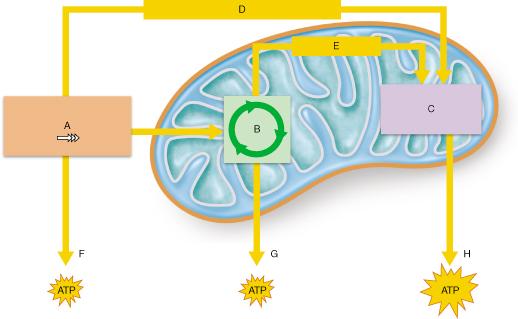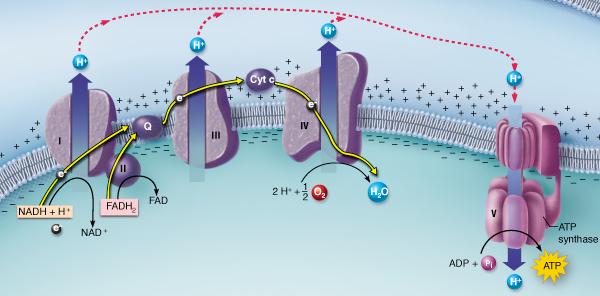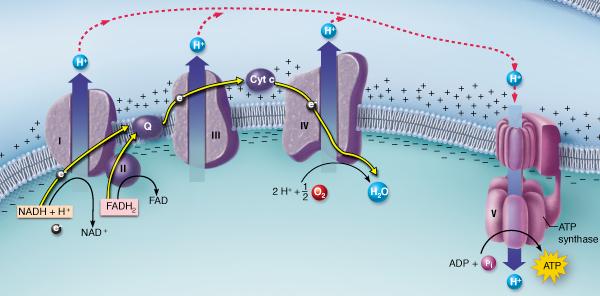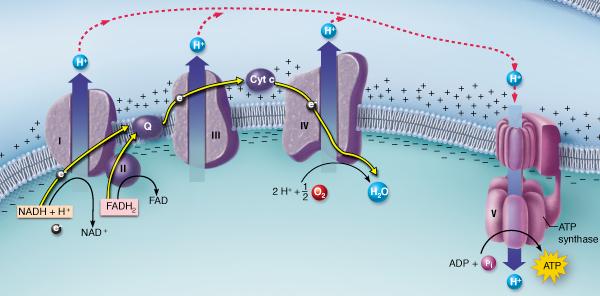To quiz yourself select the cards option from the note card set and good luck with your class.
Here are other helpful study guides:
http://www.easynotecards.com/notecard_set/70700
http://www.easynotecards.com/notecard_set/3288
http://www.easynotecards.com/notecard_set/13802
http://www.easynotecards.com/notecard_set/36677
http://www.easynotecards.com/notecard_set/13471
https://quizlet.com/57781682/metabolism-flash-cards/
The movement of H+ through the ATP synthase is best described as an example of ______.
hydrolysis
facilitated diffusion
simple
diffusion
active transport
facilitated diffusion

Oxygen is consumed during which of the lettered processes?
A
B
C
D and E
E, F, and G
C

Which of the following events is NOT depicted in the figure?
transfer of electrons and hydrogen atoms from a food molecule to
a coenzyme
formation of a high energy phosphate-phosphate
bond
generation of an electrochemical gradient across the
mitochondrial inner membrane
the reduction of an oxygen molecule
transfer of electrons and hydrogen atoms from a food molecule to a coenzyme
Proton pumps within the electron transport chain transport H+ ions ______.
from matrix to intermembrane space
from intermembrane space
to cytoplasm
from cytoplasm to matrix
from matrix to cytoplasm
from matrix to intermembrane space

Which of the following describes the event depicted on the right side of the figure?
active transport of H+ ions
oxidative
phosphorylation
substrate-level phosphorylation
oxidation of ADP
oxidative phosphorylation

Which of the following pathways act as a source for the electrons carried by the NADH and FADH2 molecules shown in this figure?
glycolysis
the krebs cycle
both A and B
neither A
nor B
both A and B
Which of the following is NOT an end product of the Krebs
cycle?
FADH2
NADH
CO2
citric acid
citric acid
Most ATP in cellular respiration is generated in glycolysis.
True
False
False
The body is able to form glucose from non-carbohydrate precursors.
True
False
True
The molecule that serves as the major source of readily available
fuel for neurons and blood cells is ________.
protein
acetyl CoA
fat
glucose
glucose
It is important to ensure that your diet is adequately rich in
vitamins because ________.
most vitamins are coenzymes needed to
help the body utilize essential nutrients
very few foods contain
vitamins
vitamins provide protection against the common
cold
all vitamins are water soluble and pass out of the body too
quickly to ensure utilization
most vitamins are coenzymes needed to help the body utilize essential nutrients
Prostaglandins play a role in ________.
skeletal muscle
contraction
noninflammatory responses
control of blood
volume
control of blood pressure
control of blood pressure
Select the correct statement about proteins.
Proteins can be
synthesized in the body if most of the amino acids are
present.
Proteins will be used by most cells for ATP synthesis if
insufficient carbohydrates are ingested.
Strict vegetarians need
not worry about adequate protein intake, as most vegetables are almost
perfect sources of amino acids.
Catabolic steroids (hormones)
accelerate the rate of protein synthesis.
Proteins will be used by most cells for ATP synthesis if insufficient carbohydrates are ingested.
The term essential nutrient refers to the chemicals that can be
interconverted in the liver so that the body can maintain life and
good health.
True
False
False
The most abundant dietary lipids in the diets of most Americans are triglycerides.
True
False
True
Ammonia, which is a byproduct of protein metabolism, is converted to
__________ primarily in the __________.
urea; liver
ketones;
kidney
ketones; liver
urea; kidney
urea; liver
The primary goal during the postabsorptive state is to
__________.
maintain blood glucose levels within an adequate
range
break down glucose in the liver
form
glycogen
build fat reserves
maintain blood glucose levels within an adequate range
The process of breaking triglycerides down into glycerol and fatty
acids is known as ________.
fat utilization
gluconeogenesis
lipogenesis
lipolysis
lipolysis
When ketone bodies are present in the blood and urine in large
amounts, it usually indicates increased metabolism of
________.
glycogen
amino acids
lactic acid
fatty acids
fatty acids
A major means for conserving heat is __________.
vasoconstriction of cutaneous blood vessels
enhanced
sweating
increased metabolic rate
increased convective loss
vasoconstriction of cutaneous blood vessels
During glycolysis, glucose must be activated by how many ATP
molecules?
one
two
three
five
ten
two
Most vitamins __________.
are metabolized to make
ATP
are used as building blocks for the body
are
carbohydrates
function as coenzymes in the body
function as coenzymes in the body
One function of vitamin A is to __________.
transfer
electrons in cellular respiration
form visual pigments
assist in blood clotting
help with calcium absorption
synthesize DNA
form visual pigments
The hormone responsible for setting the basal metabolic rate is
__________.
thyroxine
melatonin
insulin
melanin
glucagon
thyroxine
The site of electron transport is the __________.
mitochondrial matrix
mitochondrial inner membrane
(cristae)
cytoplasm
Golgi body
mitochondrial outer membrane
mitochondrial inner membrane (cristae)
The main integrating center for thermoregulation is located in the
__________.
thymus gland
spinal cord
liver
mitochondrion
hypothalamus
hypothalamus
Which coenzyme is reduced in both glycolysis and the Krebs
cycle?
manganese
NAD
coenzyme A
FAD
vitamin A
NAD
Which element below is considered a trace mineral?
sodium
phosphorus
potassium
chlorine
chromium
chromium
Which lipoprotein contains the most cholesterol?
LDL
chylomicron
VLDL
IDL
HDL
LDL
Nutritionally incomplete proteins are low in __________.
one or more of the major vitamins
one or more of the
coenzymes
one or more of the essential fatty acids
one or
more of the essential amino acids
one or more of the essential amino acids
Most of the ATP produced during cellular respiration is produced by
__________.
substrate-level phosphorylation
oxidative phosphorylation during the chemiosmotic process
glycolysis
the Krebs cycle
gluconeogenesis
oxidative phosphorylation during the chemiosmotic process
A function of the liver during the postabsorptive state is
__________.
lipogenesis
to store excess glucose by
glycogenesis
electron transport to release glucose
to
mobilize glucose reserves by glycogenolysis
glycolysis
to mobilize glucose reserves by glycogenolysis
The hormone that controls essentially all events of the absorptive
state is __________.
thyroxine
glucagon
ADH
insulin
calcitonin
insulin
Which of the following factors makes it harder for an obese person to
lose weight?
an increase in taste receptors
an
increase in thyroxine levels as fat levels accumulate
an
increase in alpha receptors (the kind that favors fat accumulation) in
fat cells
an increase in heat loss from the body that requires
more food intake
an increase in metabolism that increases appetite
an increase in alpha receptors (the kind that favors fat accumulation) in fat cells
Which of the following is the amount of energy the body needs in
order to perform only the most essential activities and is often
referred to as the “energy cost of living”?
BMR
BMI
TMR
MR
BMR
Which of the following is NOT a physiological response to
hypothermia?
reduced respiratory rate
shivering
drowsiness
dehydration
reduced heart rate
dehydration
A kilocalorie is the amount of energy __________.
stored
in 1 kilogram of water
needed to heat 1 kilogram of water
1°C
needed to move 1 kilogram of water 1 meter
needed to
heat 1 kilogram of water 1°F
needed to heat 1 kilogram of water 1°C
Essential nutrients refer to nutrients that are __________.
stored in the body for times of starvation
synthesized
every day in the body
only found in grains
limited in
synthesis and therefore must be consumed
limited in synthesis and therefore must be consumed
Prolonged high protein intake can lead to __________.
loss of bone mass
a negative nitrogen balance
kidney
damage
muscle building
loss of bone mass
Which of the following substances is considered a provitamin?
niacin
beta-carotene
iron
vitamin D
beta-carotene
Which of the following fat-soluble vitamins is NOT stored in the
body?
vitamin E
vitamin K
vitamin A
vitamin D
vitamin K
The final product of glycolysis is __________.
two
molecules of pyruvic acid, two molecules of NAD+, and a net gain of
two ATP
two FAD molecules
glyceraldehyde 3-phosphate
two molecules of acetyl coenzyme A and two molecules of carbon dioxide
two molecules of pyruvic acid, two molecules of NAD+, and a net gain of two ATP
Cyanide acts as a poison by __________.
blocking
glycolysis
interfering with the flow of electrons in the
electron transport chain
abolishing the proton gradient by
making the cristae membrane permeable to H+
irreversibly binding
to oxygen
interfering with the flow of electrons in the electron transport chain
During fasts lasting several weeks, blood glucose is maintained by
__________.
glycogenolysis
gluconeogenesis
glycolysis
lipolysis
gluconeogenesis
A low-density lipoprotein contains __________.
a low
cholesterol content
a high lipid content
a high amino-acid
content
a high protein content
a high lipid content
The role of __________ is to transport excessive cholesterol from
peripheral tissue to the liver, where it is broken down and becomes
part of bile.
very low-density lipoproteins
high-density lipoproteins
chylomicrons
low-density lipoproteins
high-density lipoproteins
The official medical measurement of obesity is the __________.
proportion of bone density to weight
body mass
index
basal metabolic rate
proportion of LDLs to body weight
body mass index
__________ acts to suppress appetite by inhibiting __________, which
is the most powerful known appetite stimulant.
Growth
hormone; lipase
Leptin; neuropeptide Y
Serotonin;
adrenaline
Insulin; glucagon
Leptin; neuropeptide Y
Which of the following statements about “redox” reactions in human
metabolism is correct?
Coenzymes accept hydrogen.
The substance being reduced loses an electron.
Oxidized
substances gain energy.
Oxidized substances lose oxygen.
Coenzymes accept hydrogen.
Which of the following is a micronutrient?
protein
carbohydrate
mineral
lipid
mineral
glucose
exclusive energy source for neurons
cholesterol
serves as a precursor to hormones and maintains the fluidity of the plasma membrane
protein
used to build enzymes
vitamins
can function as coenzymes
minerals
may be incorporated into structures to make them stronger
A person who is starving is likely to exhibit __________.
negative nitrogen balance
positive nitrogen balance
neutral nitrogen balance
nitrogen balance
negative nitrogen balance
Fat-soluble vitamins can be toxic if consumed in large
quantities.
True
False
True
Which of the following is an example of catabolism?
absorbing nutrients into the blood from the intestines
using
amino acids to make a protein
cellular respiration
lipid synthesis
cellular respiration
A substance that is reduced has lost an electron.
True
False
False
Which of the following is NOT a characteristic of glycolysis?
Glycolysis requires oxygen.
Glycolysis produces a net
gain of 2 ATP molecules per glucose molecule.
Glycolysis occurs
in the cytosol of a cell.
The final products of glycolysis
include two molecules of pyruvic acid.
Glycolysis requires oxygen.
Which of the following is a characteristic of the citric acid (Krebs)
cycle?
The citric acid cycle is an anaerobic
pathway.
The citric acid cycle occurs in the cytosol of the
cell.
Pyruvic acid directly enters the citric acid cycle.
The citric acid cycle generates a rich supply of the reduced
coenzymes, NADH and FADH2.
The citric acid cycle generates a rich supply of the reduced coenzymes, NADH and FADH2.
The final electron acceptor in the electron transport chain is
__________.
NADH
oxygen
water
CO2
oxygen
glycogenesis
the formation of glycogen to store glucose
glycogenolysis
the cleavage of glycogen to release glucose
gluconeogenesis
the process of forming glucose from noncarbohydrate molecules
beta oxidation
the initial phase of fatty acid breakdown
lipogenesis
triglyceride synthesis
As proteins are broken down for energy, __________ is generated; the
liver then converts this potentially toxic intermediate into
__________.
urea; water
ammonia; glucose
ammonia; urea
acid; ammonia
ammonia; urea
In the absorptive state, __________.
insulin serves as
the main regulatory hormone
fats are the main energy fuel
catabolism exceeds anabolism
glycogen is broken down to release glucose
insulin serves as the main regulatory hormone
In the postabsorptive state, __________.
anabolism
exceeds catabolism
insulin serves as the main regulatory
hormone
glucose is the main energy source
glycogen is
broken down to release glucose
glycogen is broken down to release glucose
__________ are considered "good" cholesterol; high blood
levels of this cholesterol are thought to be beneficial.
HDLs
LDLs
VLDLs
Chylomicrons
HDLs
Which of the following is considered a long-term regulator of feeding
behavior?
blood concentrations of amino acids and fatty
acids
cholecystokinin (CCK) levels
stimulation of stretch
receptors
leptin levels
leptin levels
The body's overall rate of energy output is called the basal
metabolic rate.
True
False
False
Which of the following would raise body temperature?
evaporation
dilation of cutaneous blood vessels
thyroxine
sweating
thyroxine